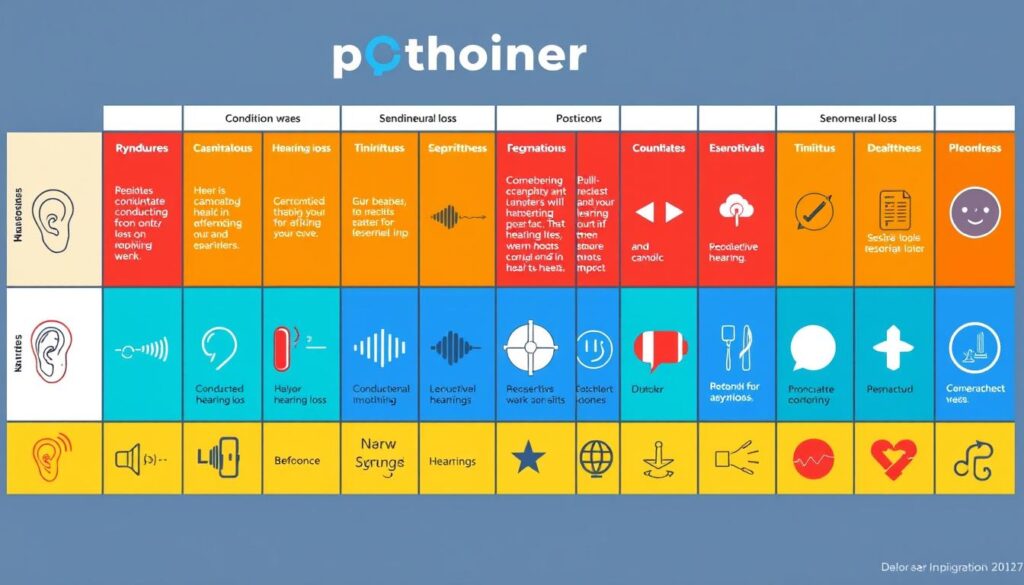Hearing Problems List: Understanding the Different Types and Causes of Hearing Loss
Have you ever wondered about the specific type of hearing problem you or a loved one might have? Understanding the different types of hearing loss is the first step towards finding the right solution.If you’re dealing with issues like tinnitus, there’s a promising product that can help resolve that persistent whooshing, buzzing, and clicking, while also improving your overall hearing and brain function. Learn more about it here.
Key Takeaways
- Hearing loss can be classified into three main types: sensorineural, conductive, and mixed.
- Sensorineural hearing loss is the most common type, often caused by damage to the inner ear or auditory nerve.
- Conductive hearing loss is more common in children and can be caused by issues like earwax buildup or bone abnormalities.
- Hearing problems can lead to cognitive impairment, depression, and an increased risk of falls in older adults.
- Preventive measures like avoiding loud noises and regular hearing tests can help reduce the risk of hearing loss.
Types of Hearing Loss
Hearing loss comes in different forms, each with its own traits and treatment options. The main types are sensorineural, conductive, and mixed hearing loss.
Sensorineural Hearing Loss
Sensorineural hearing loss is the most common issue. It happens when the inner ear nerves or hair cells get damaged. This type is usually not fixed by medicine or surgery, but hearing aids can help. If you suddenly lose your hearing, you need to see a doctor right away.
Conductive Hearing Loss
Conductive hearing loss is caused by problems in the outer or middle ear. This could be due to fluid buildup, earwax, or structural issues. It can often be fixed with medical or surgical treatments. Kids with ear infections or who put things in their ears are at higher risk.
If you or a loved one is experiencing hearing issues along with tinnitus, you can explore an effective solution designed to eliminate those disruptive sounds here.
The third type is mixed hearing loss. It combines sensorineural and conductive hearing loss.
Getting a diagnosis and treatment early is key, even more so for kids. By 65, one in three people will have hearing loss. Regular check-ups and screenings are vital.
Parts of the Ear and Auditory System
To understand hearing problems, knowing the ear and auditory system is key. The ear has three main parts: the outer ear, middle ear, and inner ear. Each part is vital for hearing.
The outer ear is what you see and includes the pinna and ear canal. It sends sound waves to the eardrum. The middle ear has the eardrum and three tiny bones called ossicles. These bones send sound vibrations to the inner ear. The inner ear has the cochlea and semicircular canals. The cochlea is key for hearing, and the canals help with balance.
The auditory system lets the brain understand sounds. The auditory nerve connects the inner ear to the brain. It carries sound information from the cochlea. This system helps us hear everything from whispers to symphonies.
Knowing the ear and auditory system is the first step to solve hearing issues. Learning about how they work helps us understand hearing problems and their treatments.
“The ear is an efficient transducer, changing sound pressure in the air into a neural-electrical signal that the brain interprets as speech, music, noise, etc.”
| Key Statistic | Value |
|---|---|
| Transmission loss in middle ear | 35 dB |
| Fluid compartments in the cochlea | 3 (scala tympani, scala vestibuli, scala media) |
| Adults in the U.S. with hearing loss | More than 37 million |
Understanding the ear and auditory system shows how complex this sensory organ is. Knowing this helps us see the challenges when any part is affected.
Hearing Problems List
Hearing problems vary widely, affecting people in different ways. They range from mild to severe. Knowing the types of hearing issues helps find the right treatment.
Common Hearing Problems
- Sensorineural Hearing Loss: This is damage to the inner ear or auditory nerve. It’s often permanent and can be mild or severe.
- Conductive Hearing Loss: This happens when the outer or middle ear has problems. It can usually be fixed with medicine or surgery.
- Mixed Hearing Loss: This is a mix of sensorineural and conductive hearing loss. It needs a special treatment plan.
- Sudden Hearing Loss: This is when hearing drops suddenly. It needs quick medical help.
- Age-Related Hearing Loss (Presbycusis): Hearing gets worse with age. It starts with high-frequency sounds.
- Noise-Induced Hearing Loss: This is from too much loud noise. Wearing ear protection can prevent it.
If you’re experiencing tinnitus or hearing issues, there’s a proven product that offers relief while improving brain function. Explore it here.
Hearing problems can affect one ear (unilateral) or both (bilateral). They can also happen before or after learning to speak. Knowing these details is key to the right treatment.

Hearing issues can greatly impact daily life. They can affect talking, socializing, and overall happiness. Finding and treating hearing problems early is vital for good hearing health.
Symptoms and Causes of Hearing Problems
Understanding hearing problems can be tough. Knowing the common symptoms and causes is key. Symptoms like trouble hearing soft sounds or struggling in loud places can really affect your day.
Common Symptoms
- Difficulty hearing soft or high-pitched sounds
- Constantly needing to turn up the volume on TVs, radios, or phones
- Struggling to understand speech in noisy environments
- Ringing or buzzing sounds in the ears (tinnitus)
- A feeling of pressure or fullness in the ears
Potential Causes
Hearing problems can come from many sources. Here are a few:
- Aging: Presbycusis, or age-related hearing loss, affects about 3 to 4 in every 10 people over 65.
- Exposure to loud noises: Over 1 billion young adults risk permanent hearing loss from unsafe listening.
- Heredity: Genetic factors can influence certain types of hearing loss.
- Head injury: Trauma to the head or ear can cause hearing issues.
- Infections: Certain infections, like otitis media (middle ear infection), can lead to hearing loss.
- Certain medications: Some drugs, like certain antibiotics and chemotherapy, can harm the inner ear.
- Circulatory problems: High blood pressure can affect blood flow to the inner ear and cause hearing loss.
- Disorders: Conditions like TMJ dysfunction or ADHD have been linked to hearing problems.
- Earwax buildup: Too much earwax can block sound and cause conductive hearing loss.
If tinnitus is part of your hearing struggles, there’s an excellent product designed to alleviate those symptoms. You can find out more here.
Diagnosis and Treatment Options
Getting the right treatment for hearing problems starts with a detailed check-up. Your doctor, like an otologist or audiologist, will run tests to figure out what’s wrong with your hearing.
They might use:
- Tuning fork tests to see if your hearing loss is in the inner ear or outer ear
- Audiometer tests by audiologists to find out the quietest sounds you can hear
After the tests, your doctor will suggest the best treatment. This could be:
- Hearing aids: These devices make sounds louder, and they come in different styles for different needs.
- Cochlear implants: For serious hearing loss, these implants go around the damaged parts of the ear and directly send signals to the nerve.
- Medical or surgical interventions: If your hearing loss is due to something in your ear, like earwax or a structural issue, your doctor might suggest removing it or fixing it surgically.
If you’re dealing with hearing issues like tinnitus, there’s a solution that can help restore your hearing while improving cognitive function. Learn more about it here.
| Treatment Option | Description | Suitable for | Cost Range |
|---|---|---|---|
| Hearing Aids | Amplify and enhance sound, available in various styles | Mild to severe hearing loss | $200 to $4,000 |
| Cochlear Implants | Bypass the damaged inner ear and directly stimulate the auditory nerve | Severe to profound hearing loss | $40,000 to $100,000 |
| Medical/Surgical Interventions | Treat underlying causes of conductive hearing loss, such as earwax removal or structural corrections | Conductive hearing loss | Varies depending on the procedure |
Getting your hearing checked early can really help your life. So, if you’re having trouble hearing, see a doctor right away.
“Hearing loss is a significant public health issue, and it’s important for people to get their hearing checked regularly, as they get older.” – Dr. Frank Lin, Professor of Otolaryngology at Johns Hopkins University
Check out This Post: https://healthsuccesful.com/choosing-the-right-ear-protection-for-concerts-and-events/
Conclusion
Hearing problems can affect anyone, regardless of age, and can range from mild inconveniences to severe impairments. By understanding the different types of hearing loss and taking preventive measures, such as regular hearing tests, you can protect your hearing health. Early detection and treatment are crucial to maintaining good hearing and overall well-being.
If you’re experiencing hearing loss, whether it’s sudden or age-related, or if you’re dealing with persistent tinnitus, seeking medical help is vital. There’s an effective product available that can help resolve tinnitus and improve brain function. Take the first step toward better hearing by exploring this solution here.
By staying proactive about your hearing health, you can manage any issues effectively and continue to enjoy a high quality of life.
FAQ
What are the different types of hearing loss?
There are three main types of hearing loss. These are sensorineural, conductive, and mixed hearing loss.
What is sensorineural hearing loss?
Sensorineural hearing loss happens when the inner ear or the hearing nerve gets damaged. This can be due to aging, loud noises, injuries, diseases, drugs, or genetics.
What is conductive hearing loss?
Conductive hearing loss occurs when sound waves can’t pass through the outer or middle ear. This can be caused by earwax, foreign objects, fluid, infections, or bone issues.
What is mixed hearing loss?
Mixed hearing loss is a mix of sensorineural and conductive hearing loss.
What are the main parts of the ear and auditory system?
The ear has three parts: the outer, middle, and inner ear. The auditory nerve connects the inner ear to the brain. This lets the auditory system process sound.
What are common symptoms of hearing problems?
Common symptoms include trouble hearing soft sounds and understanding speech in noisy places. You might also need to turn up the volume on TVs, radios, or phones.
What are potential causes of hearing problems?
Causes include aging, loud noises, genetics, head injuries, infections, certain drugs, high blood pressure, and disorders like TMJ dysfunction or ADHD.
How are hearing problems diagnosed and treated?
Hearing tests are key to figuring out the type and how bad the hearing loss is. This helps decide the best treatment. Sensorineural hearing loss often can’t be fixed with medicine or surgery, but hearing aids can help a lot. Conductive hearing loss might need medical or surgical treatment.
Source Links
- Types of Hearing Loss – https://www.hopkinsmedicine.org/health/conditions-and-diseases/hearing-loss/types-of-hearing-loss
- Hearing loss – Symptoms and causes – https://www.mayoclinic.org/diseases-conditions/hearing-loss/symptoms-causes/syc-20373072
- Hearing Problems and Deafness | Hearing Loss | MedlinePlus – https://medlineplus.gov/hearingdisordersanddeafness.html
- Types of Hearing Loss – https://www.cdc.gov/hearing-loss-children/about/types-of-hearing-loss.html
- The Four Types of Hearing Loss | CCHAT Sacramento – https://www.cchatsacramento.org/blog-and-events/the-four-types-of-hearing-loss
- Types and Causes of Hearing Loss | Starkey – https://www.starkey.com/hearing-loss/types-and-causes
- Basics of Sound, the Ear, and Hearing – Hearing Loss – https://www.ncbi.nlm.nih.gov/books/NBK207834/
- What Is Hearing? – https://my.clevelandclinic.org/health/articles/17054-hearing
- Ear diseases and disorders – https://www.healthdirect.gov.au/ear-diseases-and-disorders
- Hearing loss – https://www.nhs.uk/conditions/hearing-loss/
- Ear Disorders | Ear Problems | MedlinePlus – https://medlineplus.gov/eardisorders.html
- Hearing Loss: Causes, Symptoms, and Treatment – https://www.webmd.com/a-to-z-guides/hearing-loss-causes-symptoms-treatment
- Deafness and hearing loss – https://www.who.int/news-room/fact-sheets/detail/deafness-and-hearing-loss
- Hearing loss – https://www.healthdirect.gov.au/hearing-loss
- Hearing loss – Diagnosis and treatment – https://www.mayoclinic.org/diseases-conditions/hearing-loss/diagnosis-treatment/drc-20373077
- Hearing Loss in Adults: Differential Diagnosis and Treatment – https://www.aafp.org/pubs/afp/issues/2019/0715/p98.html
- Hearing Loss: A Common Problem for Older Adults – https://www.nia.nih.gov/health/hearing-and-hearing-loss/hearing-loss-common-problem-older-adults
- Testing Adult Hearing: Conclusions and Recommendations – Hearing Loss – https://www.ncbi.nlm.nih.gov/books/NBK207841/
- Differential Diagnosis and Treatment of Hearing Loss – https://www.aafp.org/pubs/afp/issues/2003/0915/p1125.html



